Recommendations for Reducing Housing Problems in New Zealand
VerifiedAdded on 2023/06/07
|11
|2819
|384
Report
AI Summary
This report addresses the pressing housing issues in New Zealand, including the inadequacy of suitable accommodations, increasing housing costs, and poor quality of constructions. It proposes several solutions such as revising the residency tax rate, introducing tax credits for low-income households, providing subsidies in building construction, limiting the price range of houses for first-time buyers, and implementing energy-saving policies. The report discusses the potential impacts of each solution, considering factors like revenue generation, construction costs, and infrastructure quality. Ultimately, it recommends that the Ministry of Business, Innovation and Employment (MBIE) focus on changing tax residency rates and providing subsidies to construction companies, while also revising insulation and energy consumption standards to improve housing affordability and quality in New Zealand. The document is contributed by a student and available on Desklib, a platform offering study tools for students.
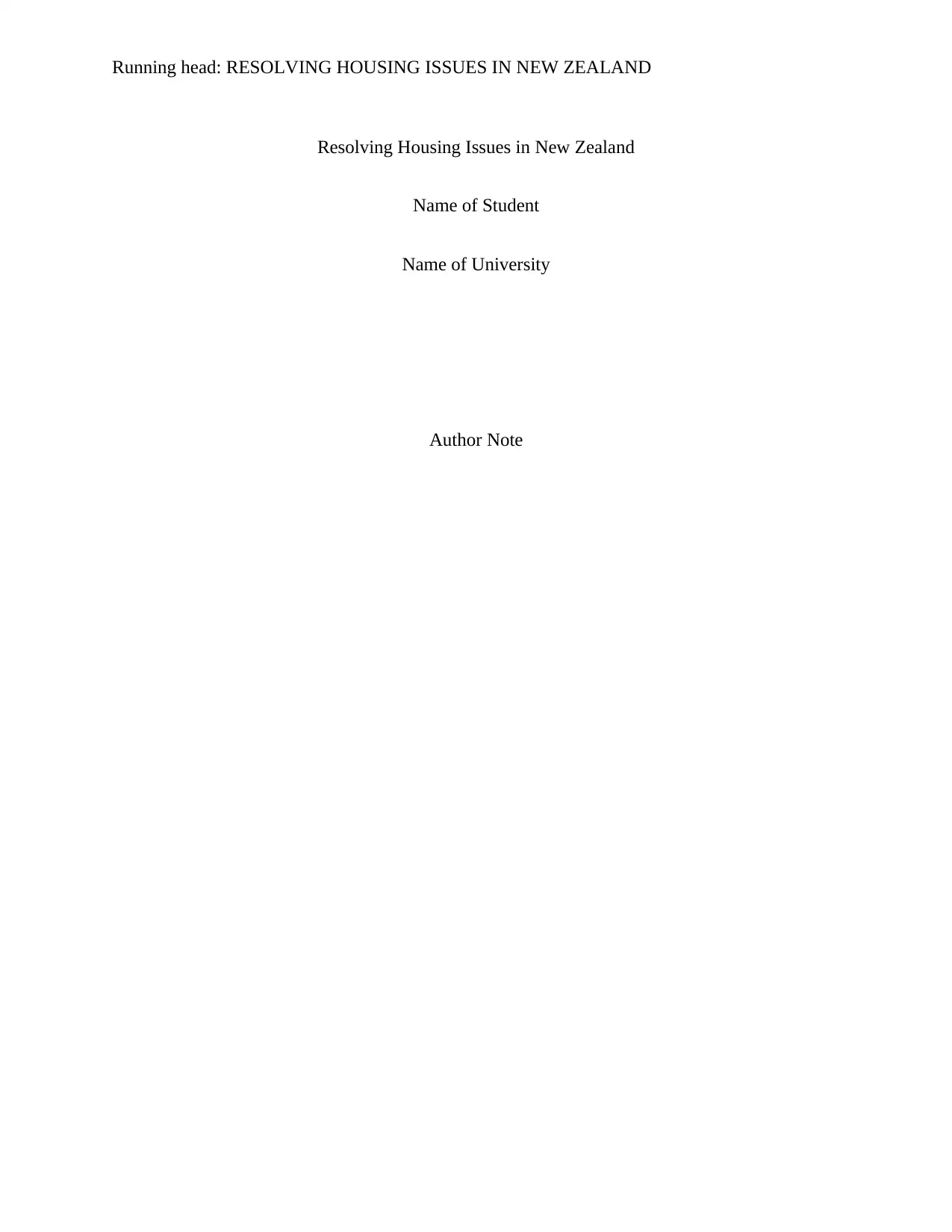
Running head: RESOLVING HOUSING ISSUES IN NEW ZEALAND
Resolving Housing Issues in New Zealand
Name of Student
Name of University
Author Note
Resolving Housing Issues in New Zealand
Name of Student
Name of University
Author Note
Paraphrase This Document
Need a fresh take? Get an instant paraphrase of this document with our AI Paraphraser
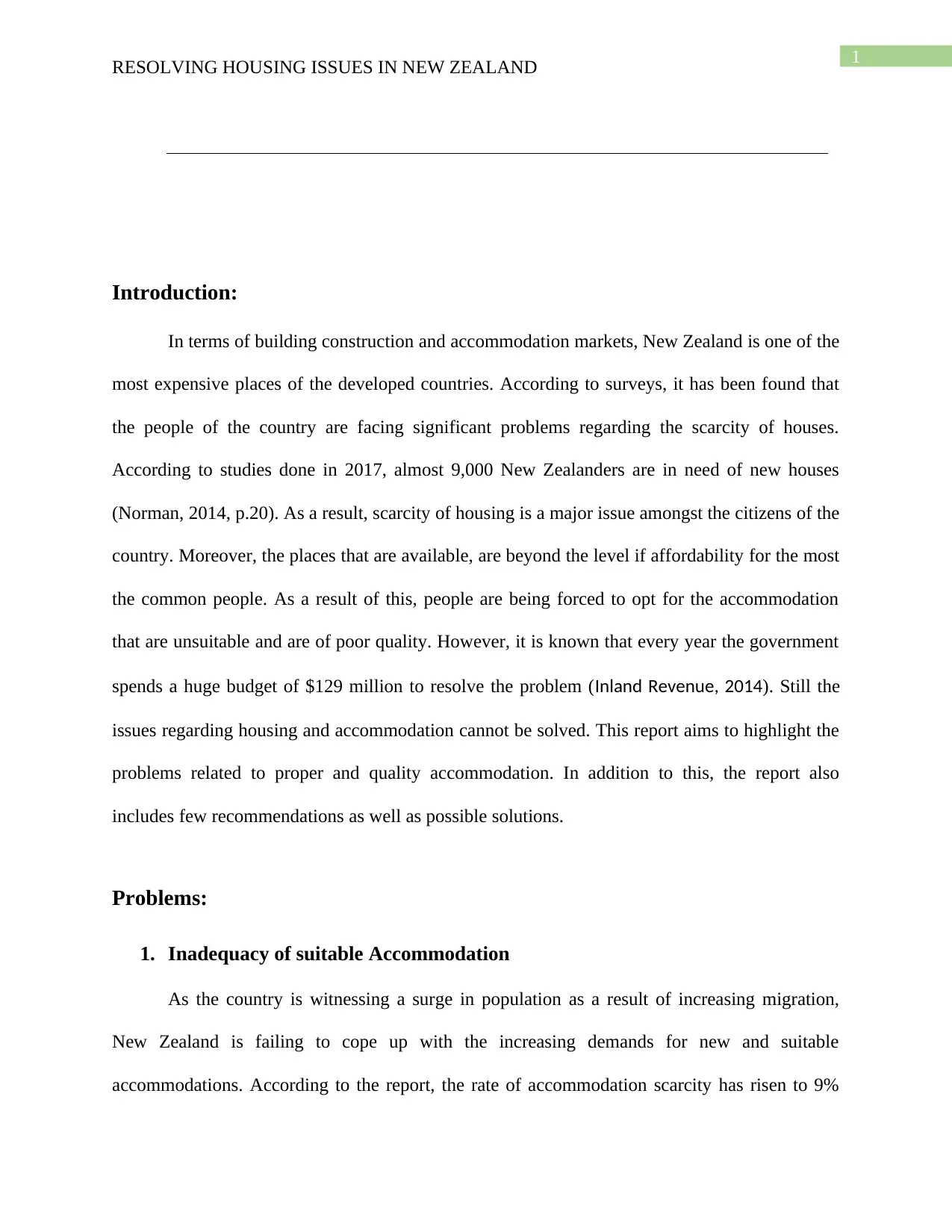
1
RESOLVING HOUSING ISSUES IN NEW ZEALAND
Introduction:
In terms of building construction and accommodation markets, New Zealand is one of the
most expensive places of the developed countries. According to surveys, it has been found that
the people of the country are facing significant problems regarding the scarcity of houses.
According to studies done in 2017, almost 9,000 New Zealanders are in need of new houses
(Norman, 2014, p.20). As a result, scarcity of housing is a major issue amongst the citizens of the
country. Moreover, the places that are available, are beyond the level if affordability for the most
the common people. As a result of this, people are being forced to opt for the accommodation
that are unsuitable and are of poor quality. However, it is known that every year the government
spends a huge budget of $129 million to resolve the problem (Inland Revenue, 2014). Still the
issues regarding housing and accommodation cannot be solved. This report aims to highlight the
problems related to proper and quality accommodation. In addition to this, the report also
includes few recommendations as well as possible solutions.
Problems:
1. Inadequacy of suitable Accommodation
As the country is witnessing a surge in population as a result of increasing migration,
New Zealand is failing to cope up with the increasing demands for new and suitable
accommodations. According to the report, the rate of accommodation scarcity has risen to 9%
RESOLVING HOUSING ISSUES IN NEW ZEALAND
Introduction:
In terms of building construction and accommodation markets, New Zealand is one of the
most expensive places of the developed countries. According to surveys, it has been found that
the people of the country are facing significant problems regarding the scarcity of houses.
According to studies done in 2017, almost 9,000 New Zealanders are in need of new houses
(Norman, 2014, p.20). As a result, scarcity of housing is a major issue amongst the citizens of the
country. Moreover, the places that are available, are beyond the level if affordability for the most
the common people. As a result of this, people are being forced to opt for the accommodation
that are unsuitable and are of poor quality. However, it is known that every year the government
spends a huge budget of $129 million to resolve the problem (Inland Revenue, 2014). Still the
issues regarding housing and accommodation cannot be solved. This report aims to highlight the
problems related to proper and quality accommodation. In addition to this, the report also
includes few recommendations as well as possible solutions.
Problems:
1. Inadequacy of suitable Accommodation
As the country is witnessing a surge in population as a result of increasing migration,
New Zealand is failing to cope up with the increasing demands for new and suitable
accommodations. According to the report, the rate of accommodation scarcity has risen to 9%
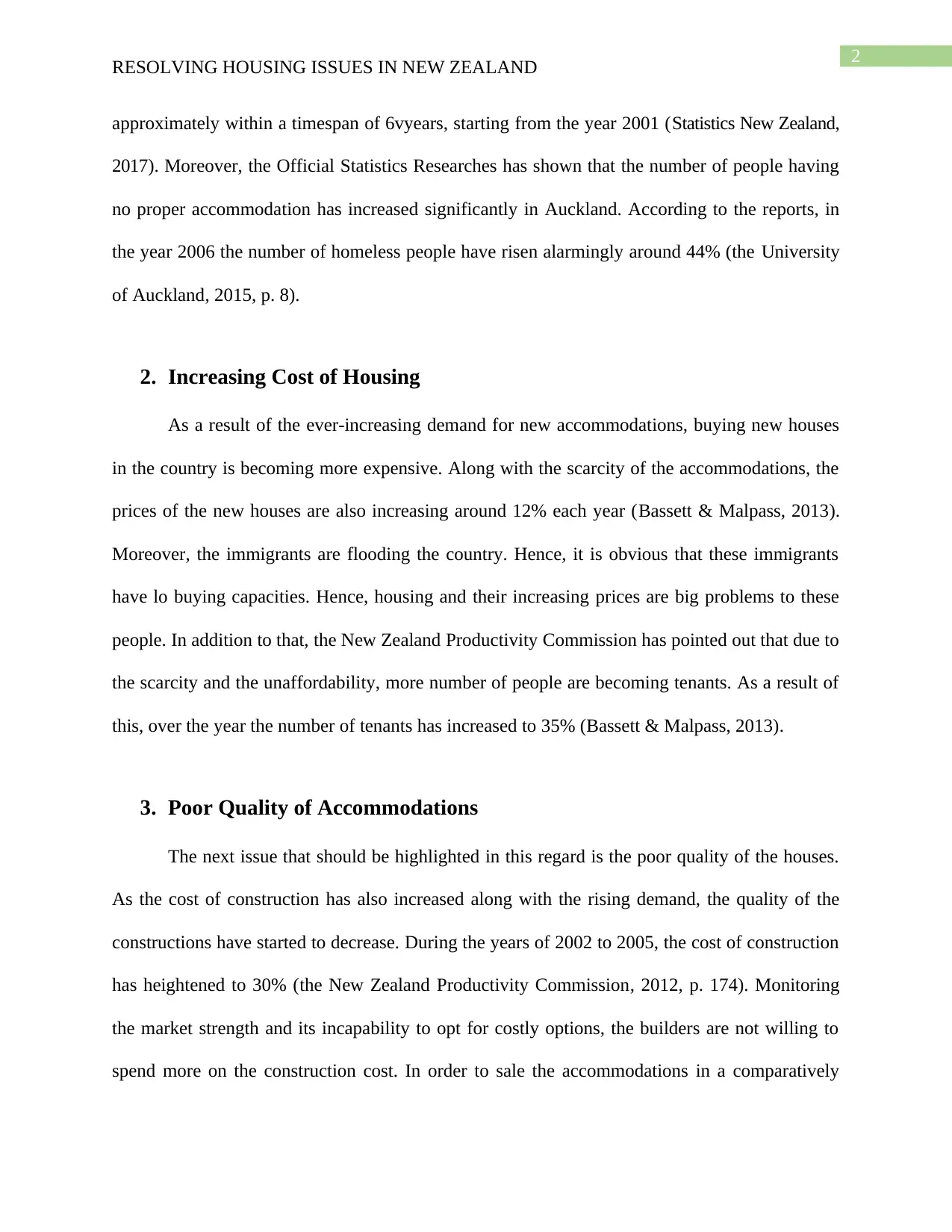
2
RESOLVING HOUSING ISSUES IN NEW ZEALAND
approximately within a timespan of 6vyears, starting from the year 2001 (Statistics New Zealand,
2017). Moreover, the Official Statistics Researches has shown that the number of people having
no proper accommodation has increased significantly in Auckland. According to the reports, in
the year 2006 the number of homeless people have risen alarmingly around 44% (the University
of Auckland, 2015, p. 8).
2. Increasing Cost of Housing
As a result of the ever-increasing demand for new accommodations, buying new houses
in the country is becoming more expensive. Along with the scarcity of the accommodations, the
prices of the new houses are also increasing around 12% each year (Bassett & Malpass, 2013).
Moreover, the immigrants are flooding the country. Hence, it is obvious that these immigrants
have lo buying capacities. Hence, housing and their increasing prices are big problems to these
people. In addition to that, the New Zealand Productivity Commission has pointed out that due to
the scarcity and the unaffordability, more number of people are becoming tenants. As a result of
this, over the year the number of tenants has increased to 35% (Bassett & Malpass, 2013).
3. Poor Quality of Accommodations
The next issue that should be highlighted in this regard is the poor quality of the houses.
As the cost of construction has also increased along with the rising demand, the quality of the
constructions have started to decrease. During the years of 2002 to 2005, the cost of construction
has heightened to 30% (the New Zealand Productivity Commission, 2012, p. 174). Monitoring
the market strength and its incapability to opt for costly options, the builders are not willing to
spend more on the construction cost. In order to sale the accommodations in a comparatively
RESOLVING HOUSING ISSUES IN NEW ZEALAND
approximately within a timespan of 6vyears, starting from the year 2001 (Statistics New Zealand,
2017). Moreover, the Official Statistics Researches has shown that the number of people having
no proper accommodation has increased significantly in Auckland. According to the reports, in
the year 2006 the number of homeless people have risen alarmingly around 44% (the University
of Auckland, 2015, p. 8).
2. Increasing Cost of Housing
As a result of the ever-increasing demand for new accommodations, buying new houses
in the country is becoming more expensive. Along with the scarcity of the accommodations, the
prices of the new houses are also increasing around 12% each year (Bassett & Malpass, 2013).
Moreover, the immigrants are flooding the country. Hence, it is obvious that these immigrants
have lo buying capacities. Hence, housing and their increasing prices are big problems to these
people. In addition to that, the New Zealand Productivity Commission has pointed out that due to
the scarcity and the unaffordability, more number of people are becoming tenants. As a result of
this, over the year the number of tenants has increased to 35% (Bassett & Malpass, 2013).
3. Poor Quality of Accommodations
The next issue that should be highlighted in this regard is the poor quality of the houses.
As the cost of construction has also increased along with the rising demand, the quality of the
constructions have started to decrease. During the years of 2002 to 2005, the cost of construction
has heightened to 30% (the New Zealand Productivity Commission, 2012, p. 174). Monitoring
the market strength and its incapability to opt for costly options, the builders are not willing to
spend more on the construction cost. In order to sale the accommodations in a comparatively
⊘ This is a preview!⊘
Do you want full access?
Subscribe today to unlock all pages.

Trusted by 1+ million students worldwide
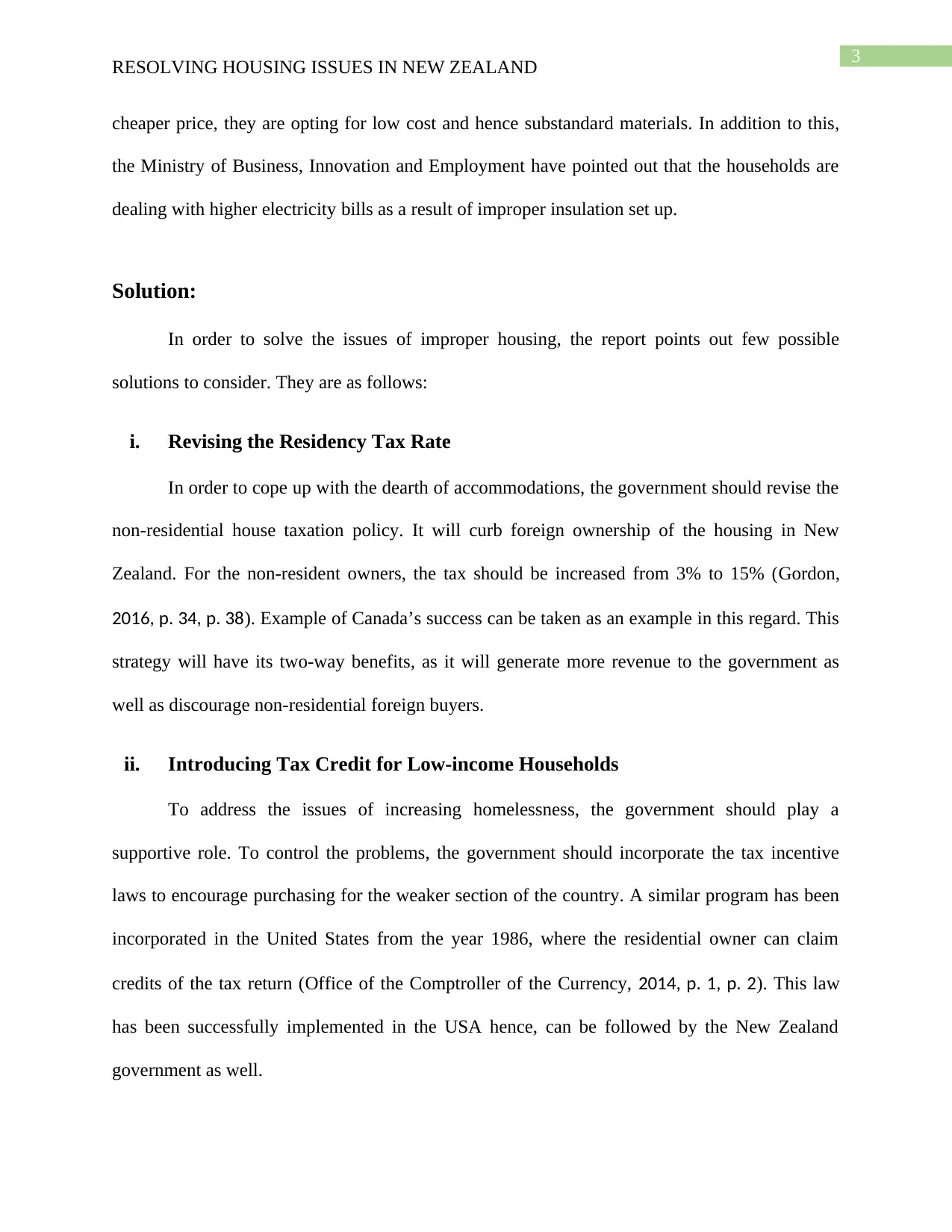
3
RESOLVING HOUSING ISSUES IN NEW ZEALAND
cheaper price, they are opting for low cost and hence substandard materials. In addition to this,
the Ministry of Business, Innovation and Employment have pointed out that the households are
dealing with higher electricity bills as a result of improper insulation set up.
Solution:
In order to solve the issues of improper housing, the report points out few possible
solutions to consider. They are as follows:
i. Revising the Residency Tax Rate
In order to cope up with the dearth of accommodations, the government should revise the
non-residential house taxation policy. It will curb foreign ownership of the housing in New
Zealand. For the non-resident owners, the tax should be increased from 3% to 15% (Gordon,
2016, p. 34, p. 38). Example of Canada’s success can be taken as an example in this regard. This
strategy will have its two-way benefits, as it will generate more revenue to the government as
well as discourage non-residential foreign buyers.
ii. Introducing Tax Credit for Low-income Households
To address the issues of increasing homelessness, the government should play a
supportive role. To control the problems, the government should incorporate the tax incentive
laws to encourage purchasing for the weaker section of the country. A similar program has been
incorporated in the United States from the year 1986, where the residential owner can claim
credits of the tax return (Office of the Comptroller of the Currency, 2014, p. 1, p. 2). This law
has been successfully implemented in the USA hence, can be followed by the New Zealand
government as well.
RESOLVING HOUSING ISSUES IN NEW ZEALAND
cheaper price, they are opting for low cost and hence substandard materials. In addition to this,
the Ministry of Business, Innovation and Employment have pointed out that the households are
dealing with higher electricity bills as a result of improper insulation set up.
Solution:
In order to solve the issues of improper housing, the report points out few possible
solutions to consider. They are as follows:
i. Revising the Residency Tax Rate
In order to cope up with the dearth of accommodations, the government should revise the
non-residential house taxation policy. It will curb foreign ownership of the housing in New
Zealand. For the non-resident owners, the tax should be increased from 3% to 15% (Gordon,
2016, p. 34, p. 38). Example of Canada’s success can be taken as an example in this regard. This
strategy will have its two-way benefits, as it will generate more revenue to the government as
well as discourage non-residential foreign buyers.
ii. Introducing Tax Credit for Low-income Households
To address the issues of increasing homelessness, the government should play a
supportive role. To control the problems, the government should incorporate the tax incentive
laws to encourage purchasing for the weaker section of the country. A similar program has been
incorporated in the United States from the year 1986, where the residential owner can claim
credits of the tax return (Office of the Comptroller of the Currency, 2014, p. 1, p. 2). This law
has been successfully implemented in the USA hence, can be followed by the New Zealand
government as well.
Paraphrase This Document
Need a fresh take? Get an instant paraphrase of this document with our AI Paraphraser
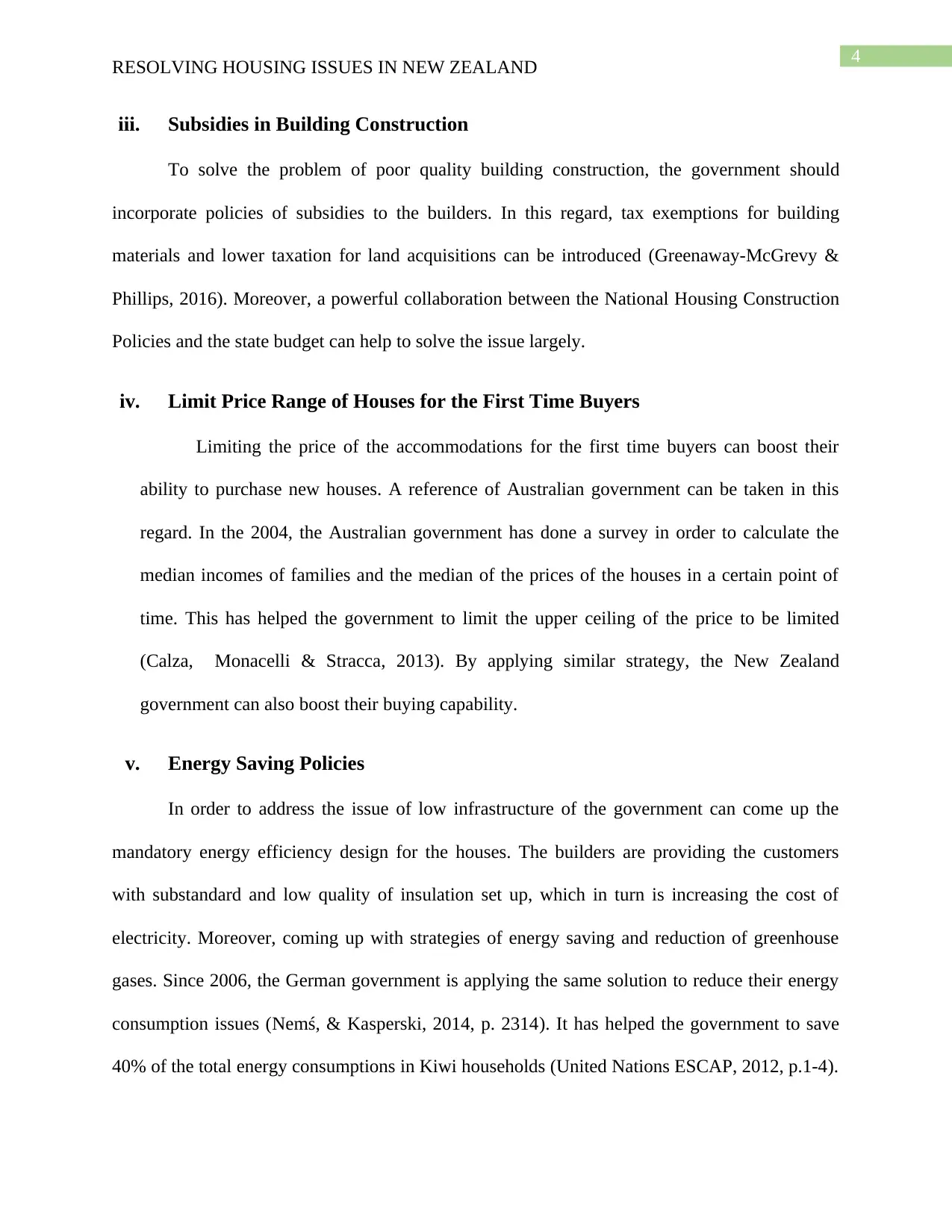
4
RESOLVING HOUSING ISSUES IN NEW ZEALAND
iii. Subsidies in Building Construction
To solve the problem of poor quality building construction, the government should
incorporate policies of subsidies to the builders. In this regard, tax exemptions for building
materials and lower taxation for land acquisitions can be introduced (Greenaway-McGrevy &
Phillips, 2016). Moreover, a powerful collaboration between the National Housing Construction
Policies and the state budget can help to solve the issue largely.
iv. Limit Price Range of Houses for the First Time Buyers
Limiting the price of the accommodations for the first time buyers can boost their
ability to purchase new houses. A reference of Australian government can be taken in this
regard. In the 2004, the Australian government has done a survey in order to calculate the
median incomes of families and the median of the prices of the houses in a certain point of
time. This has helped the government to limit the upper ceiling of the price to be limited
(Calza, Monacelli & Stracca, 2013). By applying similar strategy, the New Zealand
government can also boost their buying capability.
v. Energy Saving Policies
In order to address the issue of low infrastructure of the government can come up the
mandatory energy efficiency design for the houses. The builders are providing the customers
with substandard and low quality of insulation set up, which in turn is increasing the cost of
electricity. Moreover, coming up with strategies of energy saving and reduction of greenhouse
gases. Since 2006, the German government is applying the same solution to reduce their energy
consumption issues (Nemś, & Kasperski, 2014, p. 2314). It has helped the government to save
40% of the total energy consumptions in Kiwi households (United Nations ESCAP, 2012, p.1-4).
RESOLVING HOUSING ISSUES IN NEW ZEALAND
iii. Subsidies in Building Construction
To solve the problem of poor quality building construction, the government should
incorporate policies of subsidies to the builders. In this regard, tax exemptions for building
materials and lower taxation for land acquisitions can be introduced (Greenaway-McGrevy &
Phillips, 2016). Moreover, a powerful collaboration between the National Housing Construction
Policies and the state budget can help to solve the issue largely.
iv. Limit Price Range of Houses for the First Time Buyers
Limiting the price of the accommodations for the first time buyers can boost their
ability to purchase new houses. A reference of Australian government can be taken in this
regard. In the 2004, the Australian government has done a survey in order to calculate the
median incomes of families and the median of the prices of the houses in a certain point of
time. This has helped the government to limit the upper ceiling of the price to be limited
(Calza, Monacelli & Stracca, 2013). By applying similar strategy, the New Zealand
government can also boost their buying capability.
v. Energy Saving Policies
In order to address the issue of low infrastructure of the government can come up the
mandatory energy efficiency design for the houses. The builders are providing the customers
with substandard and low quality of insulation set up, which in turn is increasing the cost of
electricity. Moreover, coming up with strategies of energy saving and reduction of greenhouse
gases. Since 2006, the German government is applying the same solution to reduce their energy
consumption issues (Nemś, & Kasperski, 2014, p. 2314). It has helped the government to save
40% of the total energy consumptions in Kiwi households (United Nations ESCAP, 2012, p.1-4).
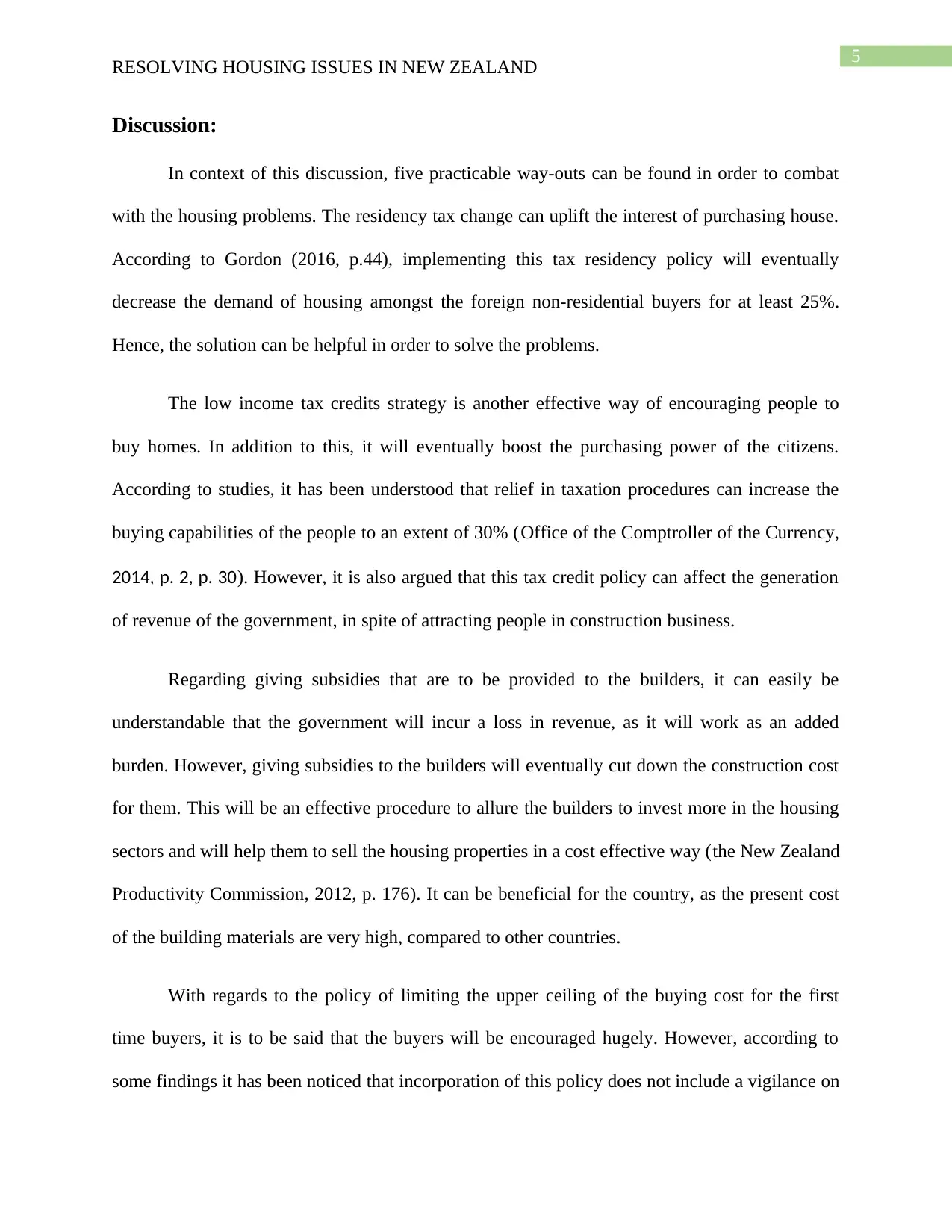
5
RESOLVING HOUSING ISSUES IN NEW ZEALAND
Discussion:
In context of this discussion, five practicable way-outs can be found in order to combat
with the housing problems. The residency tax change can uplift the interest of purchasing house.
According to Gordon (2016, p.44), implementing this tax residency policy will eventually
decrease the demand of housing amongst the foreign non-residential buyers for at least 25%.
Hence, the solution can be helpful in order to solve the problems.
The low income tax credits strategy is another effective way of encouraging people to
buy homes. In addition to this, it will eventually boost the purchasing power of the citizens.
According to studies, it has been understood that relief in taxation procedures can increase the
buying capabilities of the people to an extent of 30% (Office of the Comptroller of the Currency,
2014, p. 2, p. 30). However, it is also argued that this tax credit policy can affect the generation
of revenue of the government, in spite of attracting people in construction business.
Regarding giving subsidies that are to be provided to the builders, it can easily be
understandable that the government will incur a loss in revenue, as it will work as an added
burden. However, giving subsidies to the builders will eventually cut down the construction cost
for them. This will be an effective procedure to allure the builders to invest more in the housing
sectors and will help them to sell the housing properties in a cost effective way (the New Zealand
Productivity Commission, 2012, p. 176). It can be beneficial for the country, as the present cost
of the building materials are very high, compared to other countries.
With regards to the policy of limiting the upper ceiling of the buying cost for the first
time buyers, it is to be said that the buyers will be encouraged hugely. However, according to
some findings it has been noticed that incorporation of this policy does not include a vigilance on
RESOLVING HOUSING ISSUES IN NEW ZEALAND
Discussion:
In context of this discussion, five practicable way-outs can be found in order to combat
with the housing problems. The residency tax change can uplift the interest of purchasing house.
According to Gordon (2016, p.44), implementing this tax residency policy will eventually
decrease the demand of housing amongst the foreign non-residential buyers for at least 25%.
Hence, the solution can be helpful in order to solve the problems.
The low income tax credits strategy is another effective way of encouraging people to
buy homes. In addition to this, it will eventually boost the purchasing power of the citizens.
According to studies, it has been understood that relief in taxation procedures can increase the
buying capabilities of the people to an extent of 30% (Office of the Comptroller of the Currency,
2014, p. 2, p. 30). However, it is also argued that this tax credit policy can affect the generation
of revenue of the government, in spite of attracting people in construction business.
Regarding giving subsidies that are to be provided to the builders, it can easily be
understandable that the government will incur a loss in revenue, as it will work as an added
burden. However, giving subsidies to the builders will eventually cut down the construction cost
for them. This will be an effective procedure to allure the builders to invest more in the housing
sectors and will help them to sell the housing properties in a cost effective way (the New Zealand
Productivity Commission, 2012, p. 176). It can be beneficial for the country, as the present cost
of the building materials are very high, compared to other countries.
With regards to the policy of limiting the upper ceiling of the buying cost for the first
time buyers, it is to be said that the buyers will be encouraged hugely. However, according to
some findings it has been noticed that incorporation of this policy does not include a vigilance on
⊘ This is a preview!⊘
Do you want full access?
Subscribe today to unlock all pages.

Trusted by 1+ million students worldwide

6
RESOLVING HOUSING ISSUES IN NEW ZEALAND
the quality and infrastructure of these houses. In addition to this, by limiting the upper ceiling of
the price, the policy also assumes that all the buyers have similar capacity. Moreover, it does not
consider the non-housing costs. Hence, situation can arise where a builder can neglect the
requirement of providing proper infrastructure and insulation set up to the building (Greenaway-
McGrevy & Phillips, 2016). This hypothesis hence points towards the determination of
discrepancies in deciding the maximum limit of the buildings.
While considering the requirements of the energy consumption, insulation standard and
reduction of the electricity bills, the government should include stringent laws in employing
efficient and skilled employees by the builders (United Nations ESCAP, 2012). Moreover,
determination of the energy standard maintenance and incorporation of proper insulation is likely
to be helpful in this regard. Along with that, cost reduction strategies in non-housing costs will
also be beneficial (the University of Auckland, 2015, p. 8). However, it can be suggested that
New Zealand government should enforce these rules in a more stringent manner, as the
government does not have policies that are well framed.
Conclusion
After analyzing the problems and the possible solutions regarding accommodation in
New Zealand, the methods that involve establishing tax credits for the low-income housing, as
well as the restricting the price limit for the first bought houses are definitely to be dismissed.
Hence, to enforce changes in tax residency, subside contraction procedures, revising insulation
and energy consumption standards.
RESOLVING HOUSING ISSUES IN NEW ZEALAND
the quality and infrastructure of these houses. In addition to this, by limiting the upper ceiling of
the price, the policy also assumes that all the buyers have similar capacity. Moreover, it does not
consider the non-housing costs. Hence, situation can arise where a builder can neglect the
requirement of providing proper infrastructure and insulation set up to the building (Greenaway-
McGrevy & Phillips, 2016). This hypothesis hence points towards the determination of
discrepancies in deciding the maximum limit of the buildings.
While considering the requirements of the energy consumption, insulation standard and
reduction of the electricity bills, the government should include stringent laws in employing
efficient and skilled employees by the builders (United Nations ESCAP, 2012). Moreover,
determination of the energy standard maintenance and incorporation of proper insulation is likely
to be helpful in this regard. Along with that, cost reduction strategies in non-housing costs will
also be beneficial (the University of Auckland, 2015, p. 8). However, it can be suggested that
New Zealand government should enforce these rules in a more stringent manner, as the
government does not have policies that are well framed.
Conclusion
After analyzing the problems and the possible solutions regarding accommodation in
New Zealand, the methods that involve establishing tax credits for the low-income housing, as
well as the restricting the price limit for the first bought houses are definitely to be dismissed.
Hence, to enforce changes in tax residency, subside contraction procedures, revising insulation
and energy consumption standards.
Paraphrase This Document
Need a fresh take? Get an instant paraphrase of this document with our AI Paraphraser
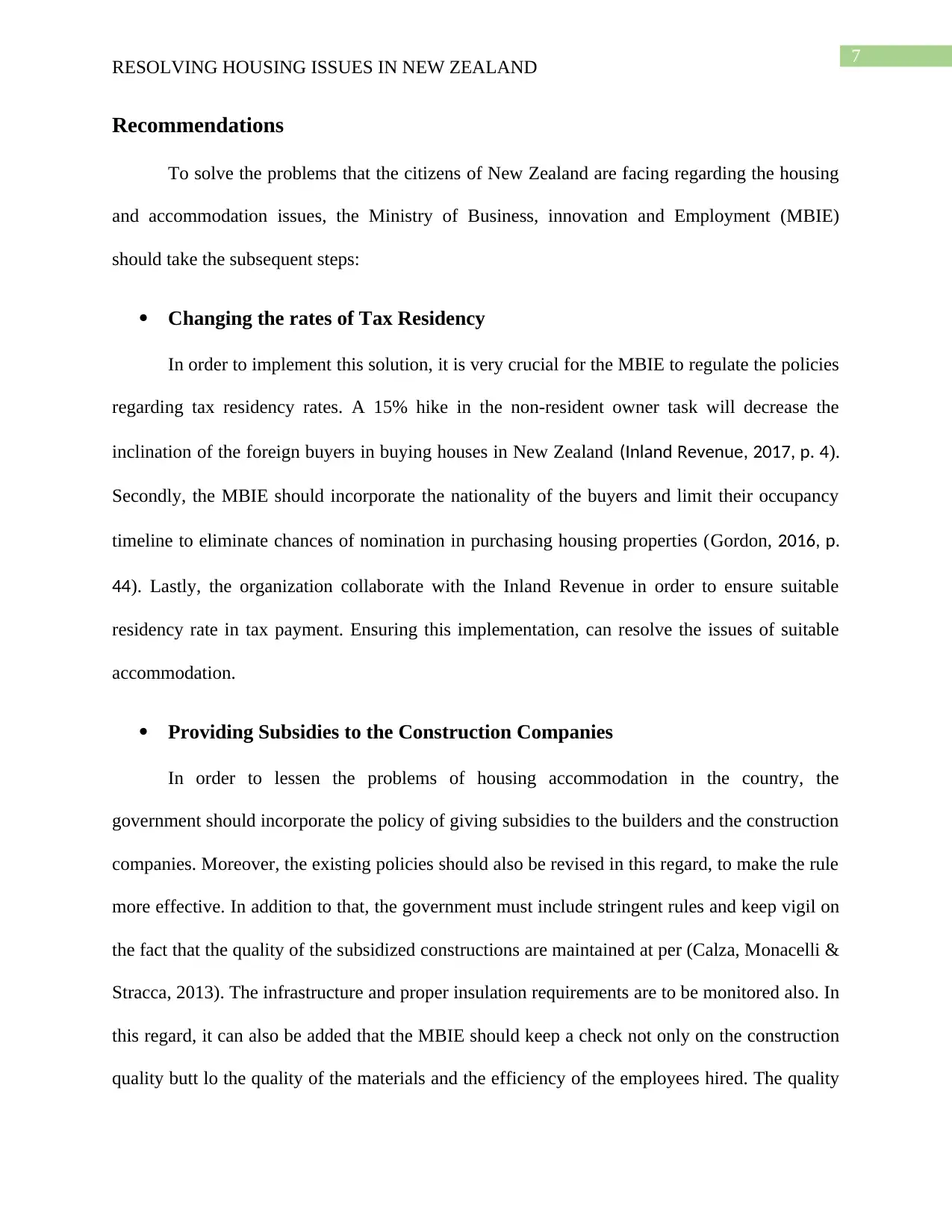
7
RESOLVING HOUSING ISSUES IN NEW ZEALAND
Recommendations
To solve the problems that the citizens of New Zealand are facing regarding the housing
and accommodation issues, the Ministry of Business, innovation and Employment (MBIE)
should take the subsequent steps:
Changing the rates of Tax Residency
In order to implement this solution, it is very crucial for the MBIE to regulate the policies
regarding tax residency rates. A 15% hike in the non-resident owner task will decrease the
inclination of the foreign buyers in buying houses in New Zealand (Inland Revenue, 2017, p. 4).
Secondly, the MBIE should incorporate the nationality of the buyers and limit their occupancy
timeline to eliminate chances of nomination in purchasing housing properties (Gordon, 2016, p.
44). Lastly, the organization collaborate with the Inland Revenue in order to ensure suitable
residency rate in tax payment. Ensuring this implementation, can resolve the issues of suitable
accommodation.
Providing Subsidies to the Construction Companies
In order to lessen the problems of housing accommodation in the country, the
government should incorporate the policy of giving subsidies to the builders and the construction
companies. Moreover, the existing policies should also be revised in this regard, to make the rule
more effective. In addition to that, the government must include stringent rules and keep vigil on
the fact that the quality of the subsidized constructions are maintained at per (Calza, Monacelli &
Stracca, 2013). The infrastructure and proper insulation requirements are to be monitored also. In
this regard, it can also be added that the MBIE should keep a check not only on the construction
quality butt lo the quality of the materials and the efficiency of the employees hired. The quality
RESOLVING HOUSING ISSUES IN NEW ZEALAND
Recommendations
To solve the problems that the citizens of New Zealand are facing regarding the housing
and accommodation issues, the Ministry of Business, innovation and Employment (MBIE)
should take the subsequent steps:
Changing the rates of Tax Residency
In order to implement this solution, it is very crucial for the MBIE to regulate the policies
regarding tax residency rates. A 15% hike in the non-resident owner task will decrease the
inclination of the foreign buyers in buying houses in New Zealand (Inland Revenue, 2017, p. 4).
Secondly, the MBIE should incorporate the nationality of the buyers and limit their occupancy
timeline to eliminate chances of nomination in purchasing housing properties (Gordon, 2016, p.
44). Lastly, the organization collaborate with the Inland Revenue in order to ensure suitable
residency rate in tax payment. Ensuring this implementation, can resolve the issues of suitable
accommodation.
Providing Subsidies to the Construction Companies
In order to lessen the problems of housing accommodation in the country, the
government should incorporate the policy of giving subsidies to the builders and the construction
companies. Moreover, the existing policies should also be revised in this regard, to make the rule
more effective. In addition to that, the government must include stringent rules and keep vigil on
the fact that the quality of the subsidized constructions are maintained at per (Calza, Monacelli &
Stracca, 2013). The infrastructure and proper insulation requirements are to be monitored also. In
this regard, it can also be added that the MBIE should keep a check not only on the construction
quality butt lo the quality of the materials and the efficiency of the employees hired. The quality
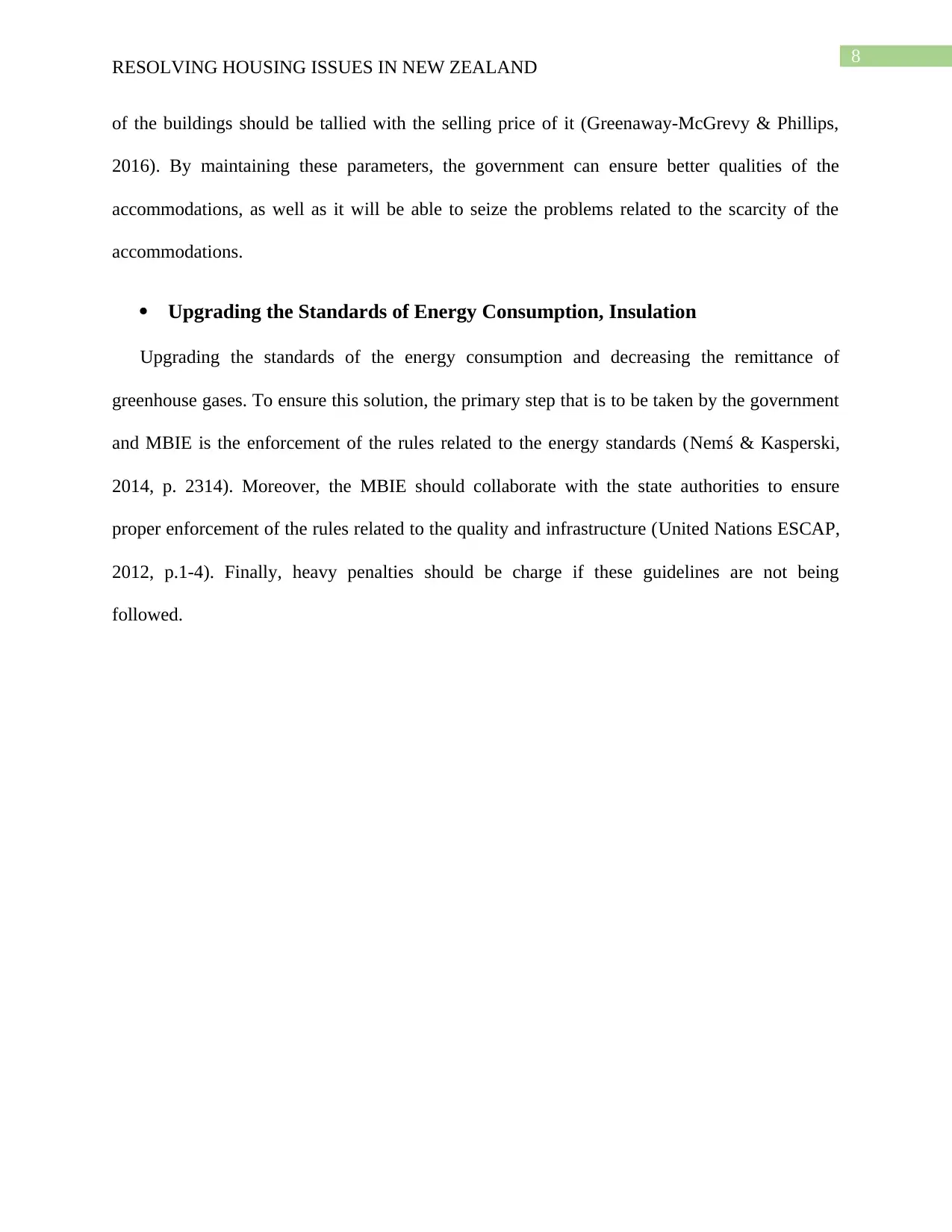
8
RESOLVING HOUSING ISSUES IN NEW ZEALAND
of the buildings should be tallied with the selling price of it (Greenaway-McGrevy & Phillips,
2016). By maintaining these parameters, the government can ensure better qualities of the
accommodations, as well as it will be able to seize the problems related to the scarcity of the
accommodations.
Upgrading the Standards of Energy Consumption, Insulation
Upgrading the standards of the energy consumption and decreasing the remittance of
greenhouse gases. To ensure this solution, the primary step that is to be taken by the government
and MBIE is the enforcement of the rules related to the energy standards (Nemś & Kasperski,
2014, p. 2314). Moreover, the MBIE should collaborate with the state authorities to ensure
proper enforcement of the rules related to the quality and infrastructure (United Nations ESCAP,
2012, p.1-4). Finally, heavy penalties should be charge if these guidelines are not being
followed.
RESOLVING HOUSING ISSUES IN NEW ZEALAND
of the buildings should be tallied with the selling price of it (Greenaway-McGrevy & Phillips,
2016). By maintaining these parameters, the government can ensure better qualities of the
accommodations, as well as it will be able to seize the problems related to the scarcity of the
accommodations.
Upgrading the Standards of Energy Consumption, Insulation
Upgrading the standards of the energy consumption and decreasing the remittance of
greenhouse gases. To ensure this solution, the primary step that is to be taken by the government
and MBIE is the enforcement of the rules related to the energy standards (Nemś & Kasperski,
2014, p. 2314). Moreover, the MBIE should collaborate with the state authorities to ensure
proper enforcement of the rules related to the quality and infrastructure (United Nations ESCAP,
2012, p.1-4). Finally, heavy penalties should be charge if these guidelines are not being
followed.
⊘ This is a preview!⊘
Do you want full access?
Subscribe today to unlock all pages.

Trusted by 1+ million students worldwide

9
RESOLVING HOUSING ISSUES IN NEW ZEALAND
Reference
Bassett, M., & Malpass, L. (2013) Priced Out: How New Zealand Lost Its Housing Affordability.
Retrieved from https://nzinitiative.org.nz/reports-and-media/reports/priced-out/
Calza, A., Monacelli, T., & Stracca, L. (2013). Housing finance and monetary policy. Journal of
the European Economic Association, 11(suppl_1), 101-122.
Gordon, J. (2016, March 30). Vancouver’s Housing Affordability Crisis: Causes, Consequences
and Solutions. Retrieved from https://fraseropolis.files.wordpress.com/2016/03/2016-
housing-affordability-crisis-report-sfu.pdf.
Greenaway-McGrevy, R., & Phillips, P. C. (2016). Hot property in New Zealand: Empirical
evidence of housing bubbles in the metropolitan centres. New Zealand Economic Papers,
50(1), 88-113.
http://m.stats.govt.nz/browse_for_stats/people_and_communities/housing/housing-
supply-demand-mr.aspx.
Inland Revenue. (2017). New Zealand tax residence. Retrieved from
https://www.ird.govt.nz/resources/4/6/46fb0ee6-4cd4-4a12-ae38-be3d13fc4cd2/ir292.pdf
Nemś, M. & Kasperski, J. (2014). A Set-up for an Experimental Verification of a New
Conception of Solar Powered House. Energy Procedia, 57, 2305-2314.
RESOLVING HOUSING ISSUES IN NEW ZEALAND
Reference
Bassett, M., & Malpass, L. (2013) Priced Out: How New Zealand Lost Its Housing Affordability.
Retrieved from https://nzinitiative.org.nz/reports-and-media/reports/priced-out/
Calza, A., Monacelli, T., & Stracca, L. (2013). Housing finance and monetary policy. Journal of
the European Economic Association, 11(suppl_1), 101-122.
Gordon, J. (2016, March 30). Vancouver’s Housing Affordability Crisis: Causes, Consequences
and Solutions. Retrieved from https://fraseropolis.files.wordpress.com/2016/03/2016-
housing-affordability-crisis-report-sfu.pdf.
Greenaway-McGrevy, R., & Phillips, P. C. (2016). Hot property in New Zealand: Empirical
evidence of housing bubbles in the metropolitan centres. New Zealand Economic Papers,
50(1), 88-113.
http://m.stats.govt.nz/browse_for_stats/people_and_communities/housing/housing-
supply-demand-mr.aspx.
Inland Revenue. (2017). New Zealand tax residence. Retrieved from
https://www.ird.govt.nz/resources/4/6/46fb0ee6-4cd4-4a12-ae38-be3d13fc4cd2/ir292.pdf
Nemś, M. & Kasperski, J. (2014). A Set-up for an Experimental Verification of a New
Conception of Solar Powered House. Energy Procedia, 57, 2305-2314.
Paraphrase This Document
Need a fresh take? Get an instant paraphrase of this document with our AI Paraphraser
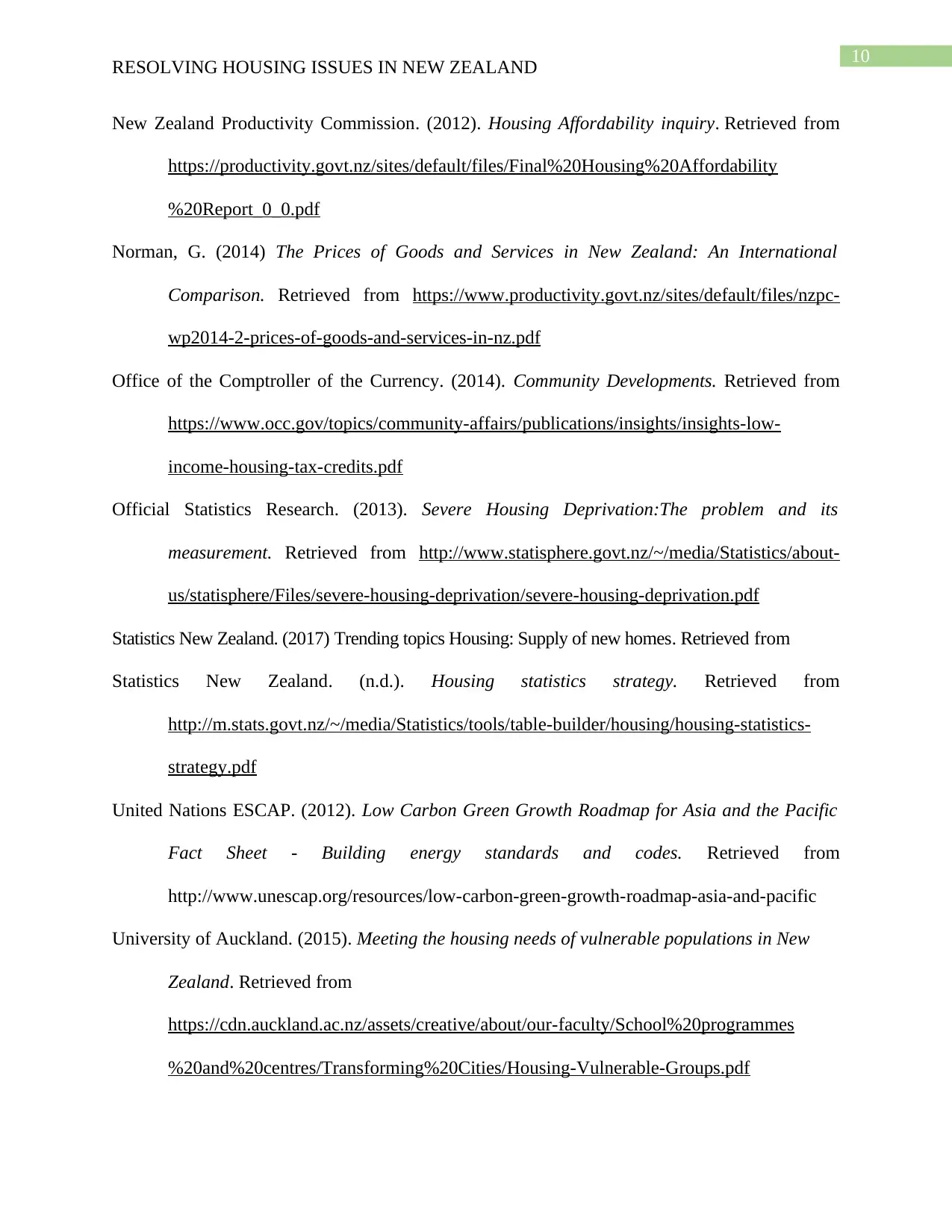
10
RESOLVING HOUSING ISSUES IN NEW ZEALAND
New Zealand Productivity Commission. (2012). Housing Affordability inquiry. Retrieved from
https://productivity.govt.nz/sites/default/files/Final%20Housing%20Affordability
%20Report_0_0.pdf
Norman, G. (2014) The Prices of Goods and Services in New Zealand: An International
Comparison. Retrieved from https://www.productivity.govt.nz/sites/default/files/nzpc-
wp2014-2-prices-of-goods-and-services-in-nz.pdf
Office of the Comptroller of the Currency. (2014). Community Developments. Retrieved from
https://www.occ.gov/topics/community-affairs/publications/insights/insights-low-
income-housing-tax-credits.pdf
Official Statistics Research. (2013). Severe Housing Deprivation:The problem and its
measurement. Retrieved from http://www.statisphere.govt.nz/~/media/Statistics/about-
us/statisphere/Files/severe-housing-deprivation/severe-housing-deprivation.pdf
Statistics New Zealand. (2017) Trending topics Housing: Supply of new homes. Retrieved from
Statistics New Zealand. (n.d.). Housing statistics strategy. Retrieved from
http://m.stats.govt.nz/~/media/Statistics/tools/table-builder/housing/housing-statistics-
strategy.pdf
United Nations ESCAP. (2012). Low Carbon Green Growth Roadmap for Asia and the Pacific
Fact Sheet - Building energy standards and codes. Retrieved from
http://www.unescap.org/resources/low-carbon-green-growth-roadmap-asia-and-pacific
University of Auckland. (2015). Meeting the housing needs of vulnerable populations in New
Zealand. Retrieved from
https://cdn.auckland.ac.nz/assets/creative/about/our-faculty/School%20programmes
%20and%20centres/Transforming%20Cities/Housing-Vulnerable-Groups.pdf
RESOLVING HOUSING ISSUES IN NEW ZEALAND
New Zealand Productivity Commission. (2012). Housing Affordability inquiry. Retrieved from
https://productivity.govt.nz/sites/default/files/Final%20Housing%20Affordability
%20Report_0_0.pdf
Norman, G. (2014) The Prices of Goods and Services in New Zealand: An International
Comparison. Retrieved from https://www.productivity.govt.nz/sites/default/files/nzpc-
wp2014-2-prices-of-goods-and-services-in-nz.pdf
Office of the Comptroller of the Currency. (2014). Community Developments. Retrieved from
https://www.occ.gov/topics/community-affairs/publications/insights/insights-low-
income-housing-tax-credits.pdf
Official Statistics Research. (2013). Severe Housing Deprivation:The problem and its
measurement. Retrieved from http://www.statisphere.govt.nz/~/media/Statistics/about-
us/statisphere/Files/severe-housing-deprivation/severe-housing-deprivation.pdf
Statistics New Zealand. (2017) Trending topics Housing: Supply of new homes. Retrieved from
Statistics New Zealand. (n.d.). Housing statistics strategy. Retrieved from
http://m.stats.govt.nz/~/media/Statistics/tools/table-builder/housing/housing-statistics-
strategy.pdf
United Nations ESCAP. (2012). Low Carbon Green Growth Roadmap for Asia and the Pacific
Fact Sheet - Building energy standards and codes. Retrieved from
http://www.unescap.org/resources/low-carbon-green-growth-roadmap-asia-and-pacific
University of Auckland. (2015). Meeting the housing needs of vulnerable populations in New
Zealand. Retrieved from
https://cdn.auckland.ac.nz/assets/creative/about/our-faculty/School%20programmes
%20and%20centres/Transforming%20Cities/Housing-Vulnerable-Groups.pdf
1 out of 11
Related Documents
Your All-in-One AI-Powered Toolkit for Academic Success.
+13062052269
info@desklib.com
Available 24*7 on WhatsApp / Email
![[object Object]](/_next/static/media/star-bottom.7253800d.svg)
Unlock your academic potential
Copyright © 2020–2025 A2Z Services. All Rights Reserved. Developed and managed by ZUCOL.





